12 COMMON BENCH PRESS MISTAKES AND HOW TO FIX THEM
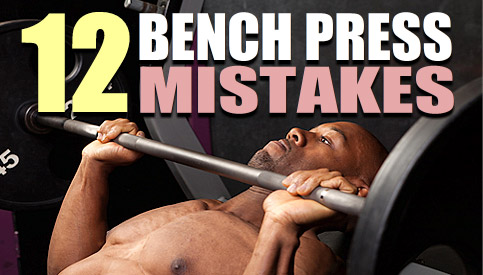
Bench press mistakes are about as common in gyms as the bench press itself.
After all, the bench press is a very simple and straightforward exercise. Just unrack the bar, lower it down to your chest, and press it back up.
Right?
Well, not quite.
Although it might seem like a very basic movement at first glance, proper bench pressing form involves a variety of technical details that shouldn’t be ignored.
Consistently bench press with improper technique, and you’ll be greatly reducing the chest-stimulating effects of the exercise while increasing your chances for injury at the same time.
In this post I’ll be outlining the top 12 bench press mistakes that lifters commonly make, and how to correct them for the very best results.
Implement these tips during your benching sessions and you should see a marked improvement in your overall chest growth, strength gains, and joint health.
Also keep in mind that these tips are not limited to the standard barbell bench press only, as they apply to dumbbell presses as well.
Let’s get started.
12 Key Bench Press Mistakes To Avoid
Bench Press Mistake #1
Going too heavy.
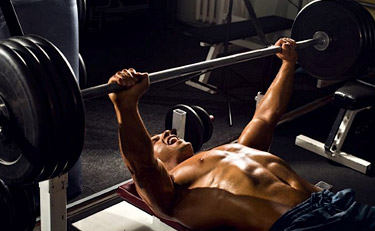
This is one of the most basic, yet most common bench press mistakes I see in the gym on a routine basis…
Guys loading up far more weight than they can truly handle and then pumping out tiny half-reps while their spotter assists throughout the entire set.
Not only does this look completely silly to anybody with even a modest knowledge of proper training, but the “ego bench presser” isn’t doing himself any favors either by lifting this way.
Benching with excessive loads reduces the stimulation on the chest by increasing the involvement of surrounding muscle groups, while at the same time significantly boosting the chances for injury by over-stressing the shoulders, wrists, and elbows.
The bottom line is that if you can’t lift the weight using proper form and a full range of motion without the constant assistance of a spotter, it’s too heavy for you. Period.
Lighten the weight up, hone your bench press technique, and focus on making steady, gradual strength increases over time rather than trying to rush things.
You’ll build your pecs more effectively this way, and your joints will thank you as well.
Bench Press Mistake #2
Flaring Your Elbows Out.
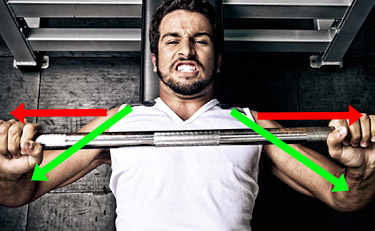
You might feel just fine benching with flared elbows for a few weeks, months, or even more, but it’s very likely going to catch up to you over time as you progress to heavier and heavier weights.
This is because flaring the elbows out at 90 degree angles places the shoulders into an excessively internally rotated position, hugely increasing the stress on the rotator cuff.
Shoulder injuries are something you really don’t want to mess around with, as they can potentially throw your entire muscle building program off course since the shoulders are involved in virtually every upper body movement you perform.
To decrease the strain on your shoulders and ensure that you’re able to bench press pain-free for years to come, make sure to tuck your elbows in slightly during the exercise.
You don’t need to overly exaggerate this (doing so will shift more of the stress onto your triceps), but an angle of about 75 degrees as seen above will be appropriate.
Bench Press Mistake #3
Bending Your Wrists.
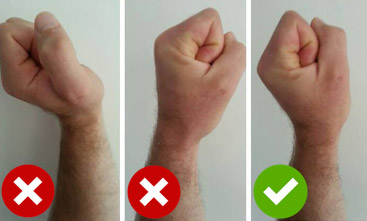
Bench pressing with your wrists in a bent position decreases your strength since the force is no longer being applied straight into the bar, and it also puts a lot of strain on the wrist joints as well.
There are two main ways to correct this…
The first is to just consciously focus on keeping your wrists in a neutral position throughout the exercise, as most people don’t even realize their wrists are bent in the first place.
The second is to set the bar across the lower portion of your hands a bit closer to your wrists:
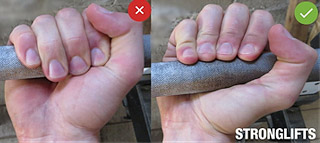
When the bar is set too high up toward your fingers, the leverage on the wrist is increased which can cause you to lose your neutral position.
Bench Press Mistake #4
Improper Grip Width.
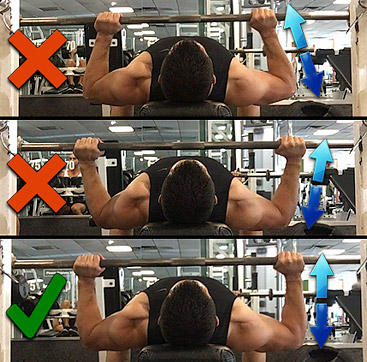
If you grip the bar too wide or too narrow, your forearms are forced into an unnatural angle that compromises your strength and increases the stress on your shoulders, elbows and wrists.
How wide should you grip the bar for optimal chest stimulation and reduced joint strain?
Since each person has differing limb lengths and overall body structure, there’s no single bench press grip width that will apply to every lifter.
The basic goal is to find the specific grip width that causes your forearms to be perpendicular to the floor in the bottom position, with your wrists and elbows stacked directly on top of eachother as seen above.
Play around with this using a lighter weight until you find the proper width for yourself. You can also videotape yourself from behind the bench to make sure you’ve found the correct position.
Bench Press Mistake #5
Lowering The Bar To Your Upper Chest.
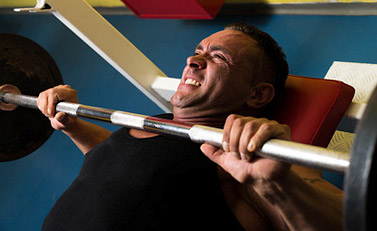
When you lower the bar too high up on your chest, your wrists and elbows will automatically fall into a misaligned position.
Your elbows will end up flaring out excessively, or if you are able to keep them tucked in, your wrists will be forced to bend.
While lowering the bar to your upper chest or neck is actually quite effective at activating the pec muscles due to the larger range of motion, it can become a huge problem for your shoulder joints as you start progressing to heavier weights.
To keep your shoulders, elbows and wrists protected, always lower the bar to your mid/lower chest area, roughly around nipple height.
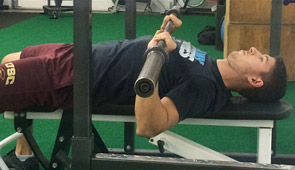
This will ensure that your elbows remain tucked while also keeping your wrists stacked directly on top of them where they should be.
Bench Press Mistake #6
Pressing With A Flat Scapula.
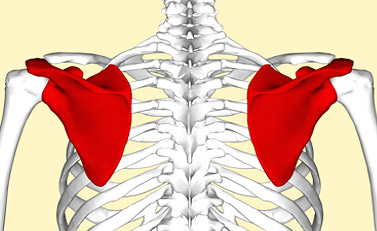
This one is among the bench press mistakes that can really hinder your progress.
When you perform the bench press with your shoulder blades flattened out, your shoulders lose their solid contact with the bench and have nothing to properly drive backward against.
Not only does this reduce the total amount of weight you can press, but it also places undo stress on the shoulder joints as well.
In order to stabilize your shoulders and prevent potential injuries, always ensure that your scapula is retracted throughout the bench press exercise.
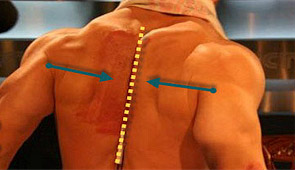
A good cue for this is to squeeze your shoulder blades together and then imagine that you’re “putting them in your back pocket”.
Keeping a small arch in your lower back will assist with this as well.
Bench Press Mistake #7
Raising Your Butt Off The Bench.
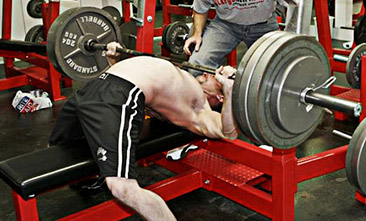
While having your lower back slightly arched and not in contact with the bench is fine since it helps to keep your chest up, your glutes should always remain tight and pinned against the bench throughout the entire set.
Trying to bench press with excessive amounts of weight and then raising your butt into the air in order to “cheat” the weight up will only increase the strain on your lower back, an area that is especially susceptible to injury.
Bench Press Mistake #8
Not Keeping A Solid Base With Your Feet.
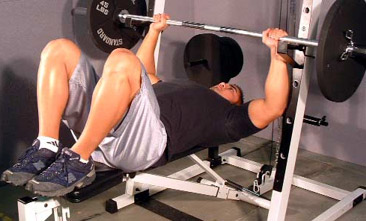
Although the bench press is an upper body exercise, it’s important to pay attention to what your lower body is doing during the lift as well.
By not keeping a solid base with your feet (or even worse, benching with your legs raised in the air) you end up in an unstable position that decreases your strength by causing you to miss out on the additional leg drive.
Instead, position your feet below your knees and drive them into the ground as you’re performing each rep.
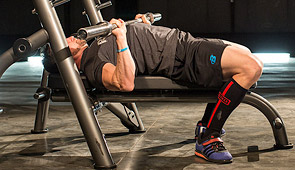
Placing them further back is also fine, but just make sure that your heels don’t come off the floor.
Bench Press Mistake #9
Using A Thumbless Grip.
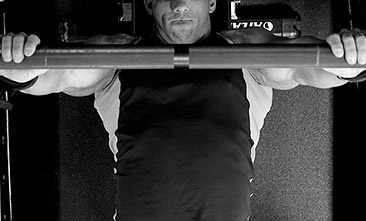
Ah, yes. Put this one in the “bench press mistakes that are accurately nicknamed.” Aka, the “suicide grip.”
Bench pressing with a thumbless grip will make it much harder to maintain a neutral wrist position throughout the exercise, and even more importantly, it will increase the chances of losing your grip altogether and dropping the bar on yourself.
People are killed in gyms every single year as a result of bench pressing accidents, and the use of a thumbless grip is no doubt a contributing factor.
To be fully on the safe side, always wrap your entire thumb around the bar.
It could potentially save you from a sudden freak accident, and at the very least it’ll help to align your wrists in the proper position for increased bench press strength and decreased joint stress.
Bench Press Mistake #10
Bouncing The Bar Off Your Chest.
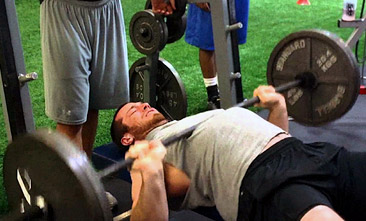
If the only way for you to complete the lift is by dropping the bar onto your chest and then bouncing it back up into the air using momentum, you’re simply going too heavy and should lighten the weight up.
There are three reasons why bouncing the bar off your chest is not recommended…
First off, from a muscle building perspective it will reduce the tension on your chest in comparison to lifting the weight under more control.
Secondly, from an injury prevention perspective it will be much more likely to hurt your shoulders or even your ribcage if you drop the bar too hard.
And thirdly, from a pure strength perspective it doesn’t count as a legal lift in the first place.
Bottom line?
Always lower the bar under control, touch your chest, and then press it back up without any bouncing movements or unnecessary outside momentum.
Bench Press Mistake #11
Lifting Heavy Without A Spotter.
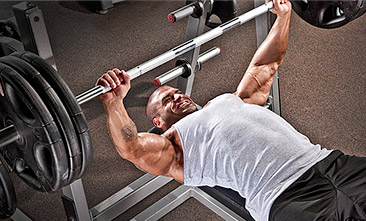
This should pretty much go without saying.
If you’re an experienced lifter and aren’t maxing out then you can probably get away with benching solo as long as the bench has safety catches, but if you’re still a beginner or are challenging yourself by lifting heavier loads (especially if it’s lower reps and close to failure) always have a spotter there just in case.
This is particularly important if you’re training from home and there’s no one around to help in case you get stuck under the bar.
Bench Press Mistake #12
Moving Your Neck And Head During The Set.
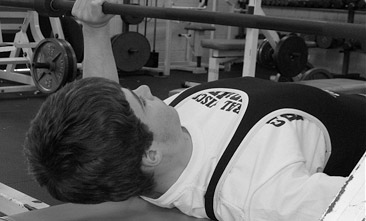
Don’t raise your head up off the bench to watch the bar hitting your chest, and don’t forcefully press your head backward into the bench either.
In addition, keep your neck in a neutral position and don’t twist it from side to side.
All of these things will increase the strain on your neck and could potentially throw you off balance during the set as well.
Bench Press Form Mistakes: Quick Wrap-up
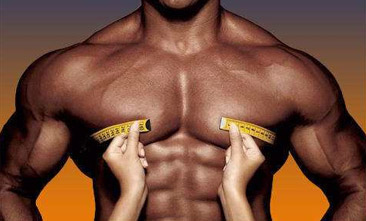
This might seem like a lot to take in at once, but perfecting your bench press form using these tips will go a long way in maximizing your chest development and preventing injuries over the long term.
Rather than trying to apply every single one of these form cues at the same time, just focus on one or two and practice them first before moving on to others.
Eventually they’ll become second nature and you won’t have to think about them anymore, much like driving a car.
To quickly recap the various bench press form tips we covered…
- Stick to weights you can handle in proper form using a full range of motion and without the constant need for spotter assistance.
- Tuck your elbows in to your side at an approximately 75 degree angle.
- Keep your wrists aligned in a neutral position.
- Use a grip width that causes your forearms to be perpendicular to the floor in the bottom position, with your wrists and elbows stacked directly on top of each other.
- Lower the bar to your mid/lower chest area, roughly around nipple height.
- Retract your scapula.
- Keep your glutes tight and pinned against the bench throughout the set.
- Position your feet below your knees and drive them into the ground on each rep.
- Wrap your entire thumb around the bar.
- Lower the weight under control and press it back up without bouncing it off your chest.
- Utilize the help of a spotter to oversee your set for safety purposes, especially if you’re going heavy or are less experienced.
- Keep your head and neck in a neutral position with your eyes looking straight ahead.
If you found these bench press tips helpful, make sure to get your personalized training, nutrition, and supplement plans using my free interactive video presentation below…
If you found this article helpful, make sure to sign up for your FREE custom fitness plan below...




